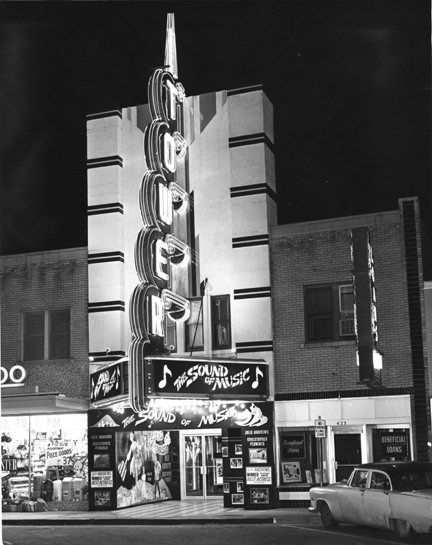
Credit for the above: okctower.com
Why many vintage movie houses called themselves, "theatRES," instead of ordinary American English, "theatERS," I don't know, but the reason must have had something to do with them saying, "We are SPECIAL," and, for many of those theaters, including this one, that's exactly what they were.
Of Oklahoma City's early suburban movie houses, the Tower wasn't among the first. The 1928 Ritz (1020 E. 13th - NE 13th & Stonewall), the 1928 Victoria (northwest corner of Classen & NW 18th), the 1928 Circle (2510 S. Robinson), and the 1919 Aldridge in Deep Deuce at 303-305 N.E. 2nd all predated the 1937 Tower Theatre at 425 N.W. 23rd, as did the 1935 Plaza at N.W. 16th and Indiana.
While not at all close to being the earliest Oklahoma City suburban movie theater, it was arguably the finest of those built before the closing of downtown's many fine movie houses in the 1970s.
The Ritz, the Circle, and the Aldridge are gone; only a vestige of the Victoria remains but in a fairly non-recognizable form. The renovated Plaza has lately fared better becoming the home of Lyric Theater today.
The Tower, despite its tough times beginning in the early 1970s and continuing through the present day, has somehow kept on hanging on, and, indeed, the Tower shows real signs that it may come to breathe new life again. This article tells the story of the old Tower Theatre and discusses what it may yet become.
The 2nd Golden Period The Downward Slope
Down But Not Out Will Rebirth Happen?
THE TOWER'S 1ST GOLDEN ERA. A brief October 25, 1936, Oklahoman article reported,
Plans are being rushed for the early start of the new Tower theater to be erected on Twenty-third street, just east of Walker avenue and it is hoped to have the auditorium ready for occupancy shortly after the Christmas holidays. The final draft of the architect's plans for this new and modern edifice calls for the latest in theater construction and convenience to patrons. It will be one of the largest of the neighborhood houses in this part of the country with both a lower floor and a balcony.While it didn't happen quite that quickly, by today's standards, it wasn't too far off the mark. A $35,000 building permit was granted by the city on March 1, 1937, and a July 4, 1937, Oklahoman article reported that the installation of the cooling system was nearing completion and that formal opening would occur in about 10 days. The article reported that seating was 1,200 and that the theater included special equipment for the hard of hearing. A parking lot north of the theater also provided for a north-side entrance, and smoking was permitted in the ventilated balcony. The article reported that,
Charles E. Watson, Oklahoma City decorator, who went to California to survey the newer Hollywood houses has chosen futuristic design for the auditorium. The Tower was designed by W. Scott Dunne, Dallas architect.The July 22, 1937, Oklahoman ad below announced the July 15, 1937, opening:
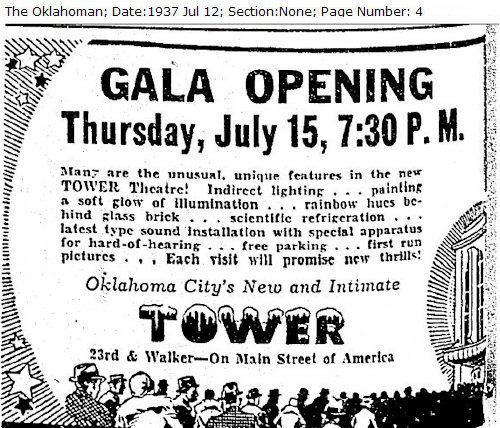
A July 11, 1937, Oklahoman article reported that "Super Sleuth" starring Jack Oakie and Ann Sothern would be the theater's 1st of many 1st-run presentations, others already booked being MGM's "Way Out West" (Laurel & Hardy), MGM's "Topper" (Cary Grant), and "Between Two Women," a drama staring Fanchot Tone and Maureen O'Sullivan.
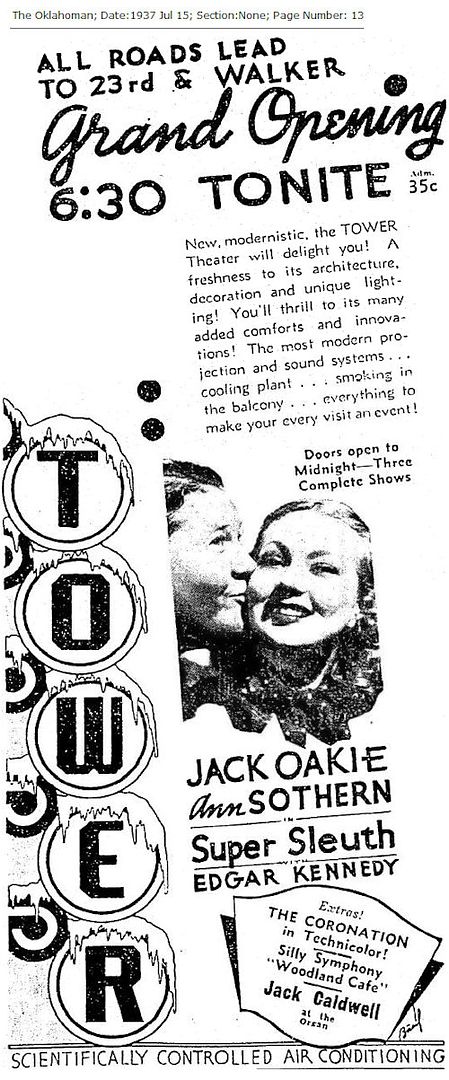
 The Tower was initially owned by the same group that owned the Criterion, Midwest, Liberty, Ritz, Victoria, Warner and Plaza theaters, the Standard Theaters Corporation, and the group's newspaper ads were typically joined together as shown in the April 17, 1938, example at the right.
The Tower was initially owned by the same group that owned the Criterion, Midwest, Liberty, Ritz, Victoria, Warner and Plaza theaters, the Standard Theaters Corporation, and the group's newspaper ads were typically joined together as shown in the April 17, 1938, example at the right.Aside from an armed robbery or two, nothing eventful appears in the Oklahoman's archives from the opening night through the 1950s — other than lots of good movies, of course. As to the 1st reported robbery which ironically occurred during a showing of William Powell and Myrna Loys' "Another Thin Man," a December 11, 1939, Oklahoman article reported that another, and non-fictional "thin man," had robbed theater staff of $1,250. The article reports, in part,
He took the money from Robert Busch, 30-year old manager of the theater, after four theater employees, the assistant manager and four patrons were forced to lie on the floor of the office. Unhurriedly, he thoroughly searched the large steel safe, took the money sacks and money box and calmly walked out of the back door of the theater.A few months later, in January 1940, the robber was apprehended in Ft. Smith, Arkansas, and was identified as being the "thin man" who had committed the offense.
[An employee said ] "He met me on the landing upstairs by the dressing room," said Virginia Bowles. * * * When I started into the dressing room he stuck a gun in my said and said, 'This is a stick up. Come along and be quiet.'"
* * *
Several times the robber begged pardon of the women of the party, once when he shoved Miss Davis, another time when he kicked the shin of Miss Loomis. * * *
* * *
Witnesses described him as about 30 years old, 5 feet 9 inches tall, slender, blond, wearing a green felt had and black overcoat.
As to the second robbery, in September 1945, it didn't match the interest or irony of the above. Three or four local teenagers stole $1,700 from Tower employees, and you can read about that here, if you want.
Below are a few ads sampling movies shown at the Tower from 1938 through 1956.
December 12, 1938 | July 10, 1939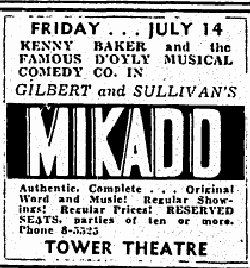 |
February 6, 1940 | May 11, 1941 |
August 24, 1941 | April 8, 1943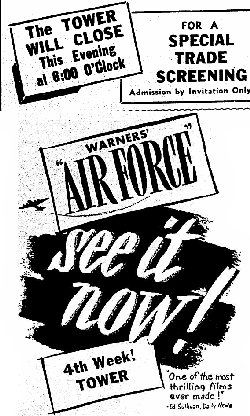 |
March 9, 1947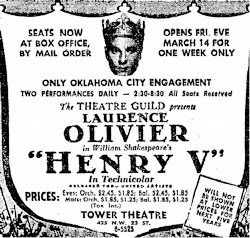 | December 30, 1947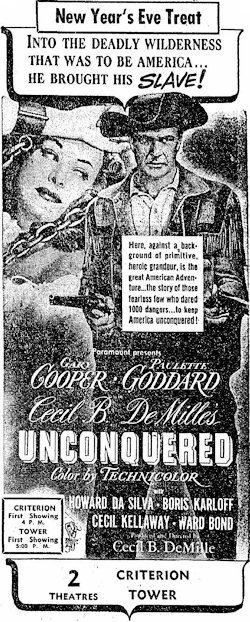 |
December 12, 1948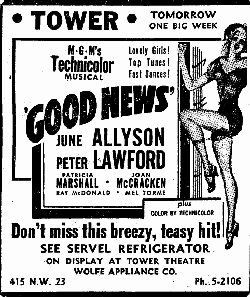 | December 18, 1954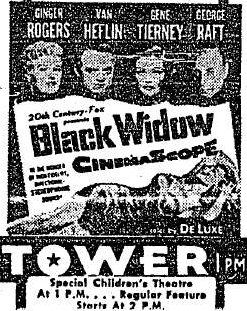 |
December 18, 1954 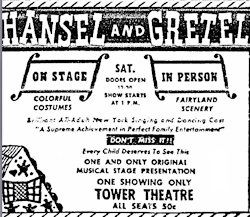 | June 30, 1956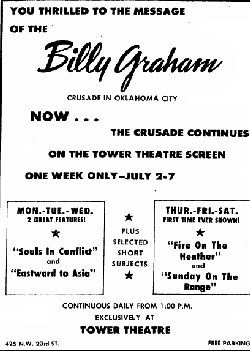 "> "> |
By 1962, it IS clear that the Cooper Foundation wished to dispose three of its theaters, the namesake Cooper, the Criterion, and the Tower. An October 31, 1962, article, reported that the Cooper Foundation had closed the Criterion and the Tower and an August 16, 1963, article reported that the three theaters were up for sale. In part, the August 16 article reported that,
George Gaughan, foundation executive of the Lincoln, Neb., based firm, said the organization "no longer wishes to operate the Criterion and Tower as motion picture theaters. We are looking for the proper buyer. For several months we have been negotiating with various persons but there is nothing at the present time to lead one to believe anything will materialize in the near future," he said.Whether or not the reason given for the Tower's closing was a ruse, a sampling of Tower's offerings in 1959 through 1962 reveals many dandy films being shown during that period of time:
* * *
The Criterion, once the entertainment showplace of the Southwest, closed its doors May 23 following the final showing of "Mutiny on the Bounty." Prior to this attraction, on Oct. 31, 1962, the foundation made a formal announcement it was closing both its Tower and Criterion Theaters due to a lack of quality motion picture products. The Criterion re-opened with "Bounty" March 21. The Tower remained closed.
May 9, 1959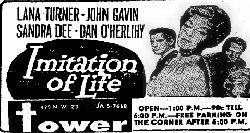 | August 23, 1959 |
November 29, 1959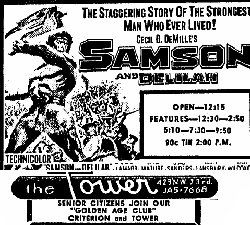 | June 19, 1960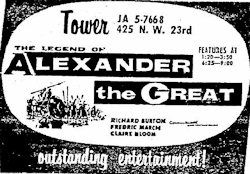 |
July 6, 1960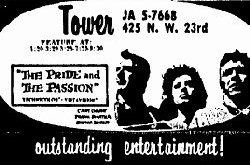 | July 21, 1960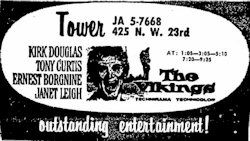 |
October 2, 1960 | December 4, 1960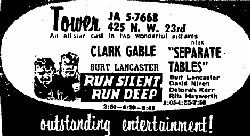 |
June 28, 1961 | November 3, 1961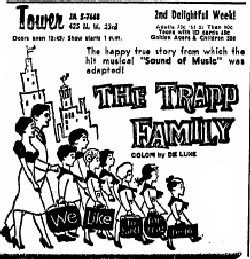 |
November 29, 1961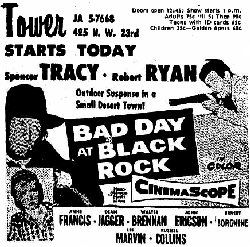 | December 8, 1961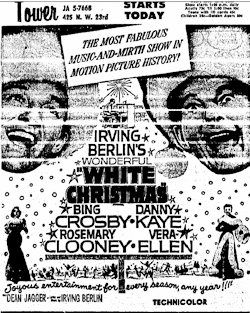 |
December 26, 1961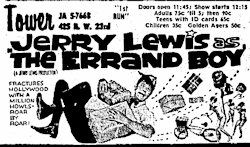 | October 5, 1962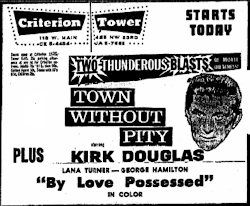 |
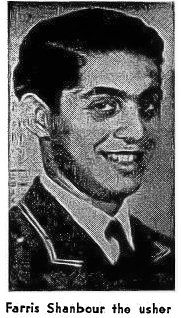 FARRIS SHANBOUR: THE 2ND GOLDEN ERA. There are really two different "Golden Eras" for the Tower — the 1st was from its birth in 1937 through the late 1950s; the 2nd commenced when the Tower was acquired in September 1963 by Farris Shanbour, a 1942 Criterion doorman and upstairs usher, and his partner Charles A. Shadid, as reported in a September 11, 1963, Oklahoman article.
FARRIS SHANBOUR: THE 2ND GOLDEN ERA. There are really two different "Golden Eras" for the Tower — the 1st was from its birth in 1937 through the late 1950s; the 2nd commenced when the Tower was acquired in September 1963 by Farris Shanbour, a 1942 Criterion doorman and upstairs usher, and his partner Charles A. Shadid, as reported in a September 11, 1963, Oklahoman article. A very nice March 26, 1967, Oklahoman article tells a good bit about Farris Shanbour before and after the time that he and his partner had also acquired the Criterion. The article traces his involvement with Oklahoma City theaters very nicely — as it said,
The reopening of the downtown Criterion is the story from which movies are made: He started in the theater in 1942 as a doorman and upstairs usher.Although the 1967 article focuses on the reopening of the Criterion, it also reflects upon his involvement in the Oklahoma City movie business, including being the Tower's manager in 1946.
When Shanbour and Shadid purchased the Tower, they already owned and operated the Plaza and Hillcrest Drive In theaters. In the September 9, 1963, article, Shanbour was reported to say that the Tower would be operated as a first run theater, that some remodeling would be done, and that the theater would reopen in November.
 It did. After a $10,000 remodeling plus installation of $30,000 of new Todd-AO equipment, the Tower's new owners made their announcement that the Tower would reopen with a bang on November 13, 1963, with the 1st city showing of "Cleopatra" starting Elizabeth Taylor, Richard Burton, and Rex Harrison. The extravagantly produced, often critically panned, production certainly made the point that the Tower Theatre was back in business, big time.
It did. After a $10,000 remodeling plus installation of $30,000 of new Todd-AO equipment, the Tower's new owners made their announcement that the Tower would reopen with a bang on November 13, 1963, with the 1st city showing of "Cleopatra" starting Elizabeth Taylor, Richard Burton, and Rex Harrison. The extravagantly produced, often critically panned, production certainly made the point that the Tower Theatre was back in business, big time.And it was. Under the Shanbour/Shadid ownership and management which lasted until early March 1970, the Tower Theatre was, indeed, a place entitled to the "I'm special" spelling of its name.
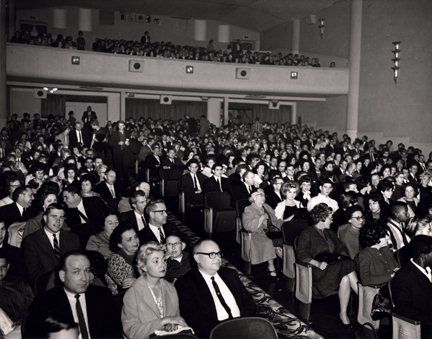
Credit for the above: okctower.com
Shanbour apparently had less difficulty in booking quality productions than the Cooper Foundation's excuse for closing the Tower would appear to justify. More likely, the quality (read: popularity) of movies shown had to do with willingness to engage in stiff competition for movie titles. This September 25, 1966, Oklahoman article reported that:
Oklahoma City is slightly unique in that of its 46 theaters, 14 of these show first run attractions. These 14 are operated by eight different companies instead of single ownership of the majority of first run houses in other major cities.Farris Shanbour didn't always get first run movies but of the 58 or so productions at the Tower those that were not first run were almost always excellent movies. I've compiled a chronological list of what I call "The Tower's Movie Legacy Under Shanbour & Shadid" and you can see it here.
All first run films are played on a bid basis — the distributor simply takes the highest bid — and the local competition is sometimes financially severe.
First run houses outnumber practically every major city in the U.S. Theater ownerships include the Center and State, State Theaters, Inc.; Midwest, Greater Oklahoma City Amusements Inc.; Villa, Farris [ed note: should be Ferris] Enterprises; Shepherd Twin, Snyder-Ashley Enterprises, and the Will Rogers and May, Video Theaters Inc.
"Cleopatra" completed its road show run on May 14, 1974, after being shown for 26 weeks. A couple of additional photos from okctower.com are shown below:
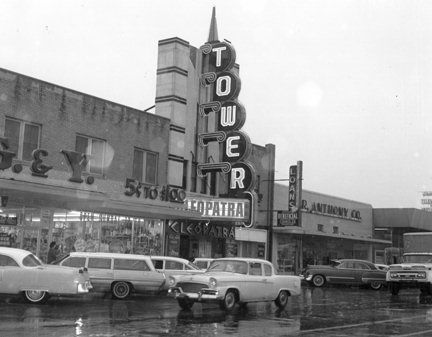
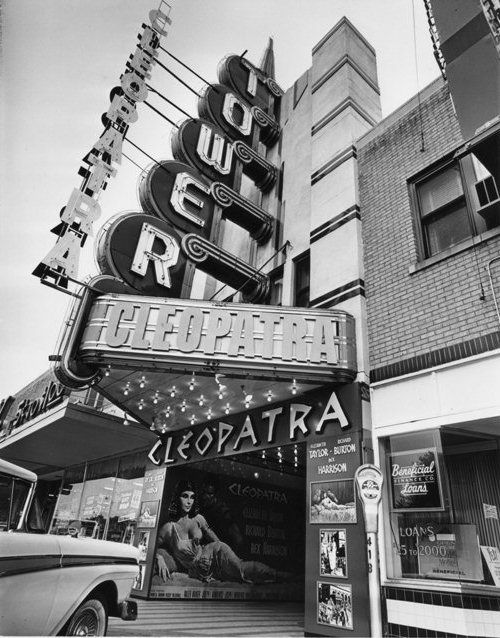
First run showings in 1964 after Cleopatra were "The Chalk Garden" (Haley Mills, Deborah Kerr), "What A Way To Go" (Shirley MacLaine, Robert Mitchum, Dean Martin), "The Unsinkable Molly Brown" (Debbie Reynolds), "The Fall of the Roman Empire" (Sophia Loren, Richard Boyd, Alec Guiness, James Mason, Omar Sharif), "The Outrage" (Paul Newman, Laurence Harvey), "Guns At Batasi" (Richard Attenborough, Jack Hawkins), and "The Americanization of Emily" (James Garner, Julie Andrews). The photo below from okctower.com shows what NW 23rd and Walker looked like on a popular movie night:
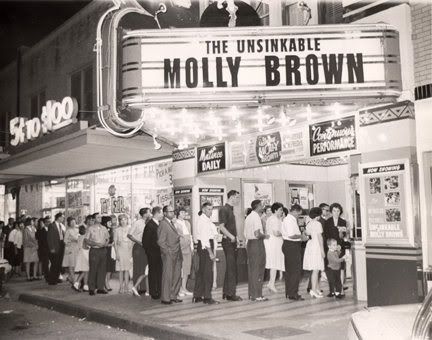
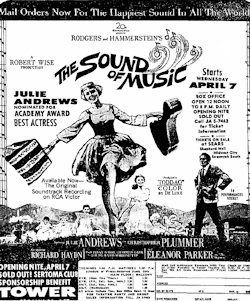 As good as such lines were, the Tower is probably remembered by most for its hosting of "The Sound of Music."
As good as such lines were, the Tower is probably remembered by most for its hosting of "The Sound of Music."Click the ad for a larger view.
"The Sound of Music" opened at the Tower on April 7, 1965, for a run intended to close on June 23, 10 weeks later. Instead, the last showing was on November 1, 1966, a run of 82 consecutive weeks. The September 12, 1996, Oklahoman article shown below shows Farris Shanbour at the right receiving a plaque from a 20th Century Fox representative for the longest running movie in Oklahoma's history. Following that are three additional photos from okctower.com.
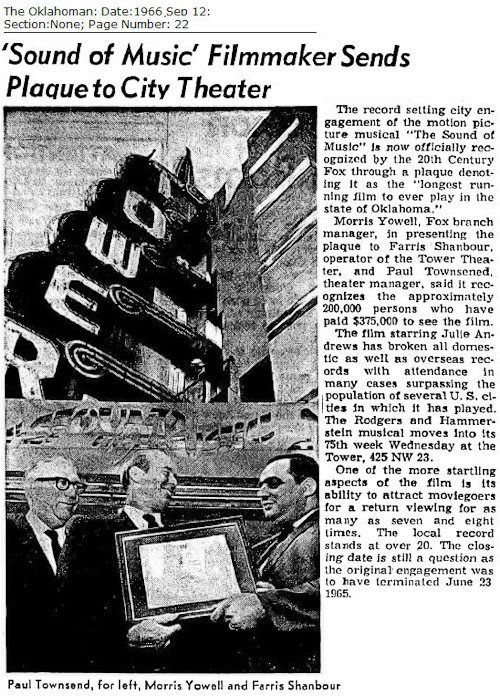


Inside During "Sound of Music"
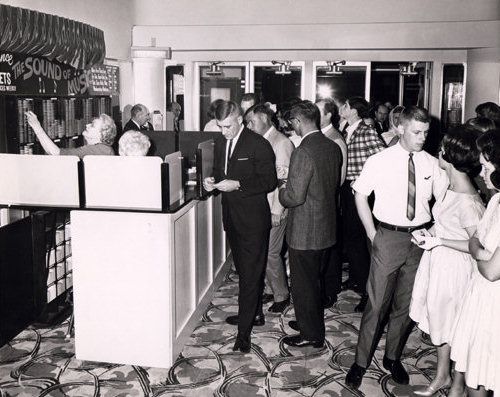
Shanbour and his financial partner weren't content to leave well enough alone. In June 1966 they remodeled an old church and turned it into the Park Terrace Theater at 5801 S. Western thereby giving the Capitol Hill vicinity its first new theater in decades. At the Tower, the September 25, 1966, Oklahoman article mentioned earlier said that $300,000 was then being spent on remodeling but the next article mentioned places the number at $50,000 and another articles uses the smaller number, also.
Whichever, after the "Sound of Music" closed its run on November 1, 1966, on January 16, 1967, a 3-alarm fire essentially gutted the Tower's interior and caused damages of $200,000. This January 17, 1967, Oklahoman article gives the report. At about 11:25 p.m., about 20 minutes after the last show of "The Blue Max," a fire broke out in the balcony. None were injured. After the fire, Shanbour projected that the theater would remain closed for at least six months.
 Possibly, he was downhearted and depressed when making that projection because Shanbour obviously got his competitive juices flowing quickly since a February 21, 1967, article reported that the Tower would reopen in March. By this time, Shanbour and Shadid had also acquired the Criterion and were determined to restore the downtown classic icon to its former glory (which they did).
Possibly, he was downhearted and depressed when making that projection because Shanbour obviously got his competitive juices flowing quickly since a February 21, 1967, article reported that the Tower would reopen in March. By this time, Shanbour and Shadid had also acquired the Criterion and were determined to restore the downtown classic icon to its former glory (which they did).But, as to the Tower, it opened on March 22 with the showing of yet another blockbuster, "The Sand Pebbles" starring Steve McQueen and the movie had a run of 19 weeks, ending on August 1.
Throughout the remainder of Shanbour's operation of the Tower, it continued to run many first run films with a mix of some good oldies.
Other 1st runs in 1967 were "The Flim Flam Man" (George C. Scott, Sue Lyon) and the opening of "Camelot" staring Richard Harris and Vanessa Redgrave. In 1968, "Camelot" finished its run of almost 25 weeks, followed by other first run films: "Half A Sixpence" (Tommy Steele); "Private Navy of Sgt. O'Farrell" (Gina Lollobrigida, Bob Hope, Phyllis Diller); "The Fox" (Sandy Dennis, Keir Dullea, Anne Heywood), "Prudence and the Pill" (Deborah Kerr, David Niven); "Therese & Isabelle" (Essy Persson); "The Split" (Jim Brown, Gene Hackman, Ernest Borgnine); "Coogan's Bluff" (Clint Eastwood); and "Star" (Julie Andrews, Richard Crenna).
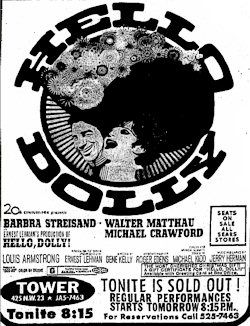 In 1969, "Star" completed its run followed by "Faces" (John Marley, Gena Rowlands); "Night of the Following Day" (Marlon Brando, Richard Boone); "Midas Run" (Richard Crenna, Anne Heywood, Fred Astaire); "Loves of Isadora" (Vanessa Redgrave); "The April Fools" (Jack Lemmon, Catherine Deneuve); "Staircase" (Rex Harrison, Richard Burton); "Libertine" (Catherine Spaak); "Me, Natalie" (Patty Duke); "A Nice Girl Like Me" (Barbara Ferris, Harry Andrews); and ending the year with "Hello Dolly" (Barbara Streisand, Walter Matthau) which opened on December 17, 1969.
In 1969, "Star" completed its run followed by "Faces" (John Marley, Gena Rowlands); "Night of the Following Day" (Marlon Brando, Richard Boone); "Midas Run" (Richard Crenna, Anne Heywood, Fred Astaire); "Loves of Isadora" (Vanessa Redgrave); "The April Fools" (Jack Lemmon, Catherine Deneuve); "Staircase" (Rex Harrison, Richard Burton); "Libertine" (Catherine Spaak); "Me, Natalie" (Patty Duke); "A Nice Girl Like Me" (Barbara Ferris, Harry Andrews); and ending the year with "Hello Dolly" (Barbara Streisand, Walter Matthau) which opened on December 17, 1969. With "Hello Dolly," the Shanbour/Tower era would end with a bang. A March 5, 1970, Oklahoman article reported that Shanbour & Shadids' holdings had been leased "for an extended time" to Spetro Threatres, owned by Ferris Enterprises which, by that time, already included the Centre, Villa, State, Edmond Plaza, Hollywood in Norman, Apollo Twin and Cinema 70 Drive In. Also by this time, Shanbour and Shadid had built the Quail Twin so it and the Plaza, park Terrace, Winchester Drive In, Hillcrest Drive In, and the Tower were included in the transaction, bringing under Spectro's banner 17 of the 53 screens in the Oklahoma City area. While the Tower under Spectro's flag would continue to do well for a time, the transfer marked the end of the Shanbour era as far as the Tower and other theaters were concerned. "Hello Dolly" closed on May 20, 1970, following a run of 22 weeks.
During the remainder of 1970 and for a time thereafter, the Tower continued Shanbour's tradition of showing quality films, even if fewer first-run blockbusters are apparent from the list. In 1970, the list included "The Walking Stick," "The Games," "2001: A Space Odyssey," "The Boys in the Band," "Fantasia," "The Strawberry Statement," "The People Next Door,", "Brotherly Love," "Sunflower," "Dr. Zhivago," "Diary of a Mad Housewife," and "Song of Norway."
By a couple of years or so, Spectro's stable of theaters and the quality of Tower's film offerings diminished. At some point in early 1974, Spectro ceased its operations. The last ad that I found for the group, including the Tower, was in early February 1974 — I found no accompanying article which made a closing announcement, I found only the absence of movie ads. A March 3, 1974, Oklahoman article provided after-the-fact verification that Spectro had shut down. Parts of the article read:
Spectro Theater movies, dark for the first time in memory of area patrons, will light their screens again within two weeks, owner Maurice Ferris predicted Saturday. Ferris said either he or a new owner from Texas will pump new vitality into the ailing 11-theater, 13 screen chain. Only Spectro houses in Norman and Edmond were functioning Saturday, Ferris said.Whether some part of the deal went through or not is not clear from the Oklahoman's archives, but what IS clear is that no Tower Theatre ads appeared in the Oklahoman between early February 1974 until May 1976 — or, at least, I couldn't find any and I looked closely. The Tower was not one of the theaters owned by Spectro — although the Tower was leased to others after Farris Shanbour and Charles Shadid ended their operation of the Tower, their ownership of the property was retained.
* * *
Late Saturday, Bill J. Hardy of Dallas was due in Oklahoma City to continue negotiations for his purchase of the Spectro chain. "It's premature to say anything," Hardy said from his Dallas office. "I can say Maurice and I have made a deal on five of the houses. The other six, which he does not own, I'm not sure about."
As a side-note, after leasing the Tower and other theaters to Spectro, Farris Shanbour went on to establish several new suburban theaters under the Oklahoma Cinema Theatres, Inc., banner: North Park Cinema 4, MacArthur Park Cinema 4, Heritage Park Cinema III, French Market Twin, the Almonte 6, Heisman Cinema 4 in Norma, and the NW Cinema 70 Drive-in. In this December 12, 1971, article, he said, "I just couldn't stay out of the business."By this May 12, 1976, ad, the Tower reappeared in the ads as part of an unidentified operation which showed the Tower, Park Terrace, South Park, Cinema 4 and Hillcrest Drive In as parts of the group. The modest ad showed that "Sparkle" with Bruce Lee was a first run attraction at the Tower. Later Oklahoman articles showed that the group was called "Heritage Theaters" managed by George Grube. That pattern appears to have continued until and ended in July 1979.
In July 1977, Heritage Theaters filed a federal court lawsuit against 20th Century Fox and Oklahoma Cinema, Inc., owner of the North Park Theater (the corporate principal being Farris Shanbour), claiming that it had been discriminated against in the competitive bidding for first-run movies. The claim was in part based on the allegation that its competitors were allowed to see other bids before making their own. I don't know the outcome of that litigation, but operation of the Tower did not continue in Heritage Theaters hands much longer.
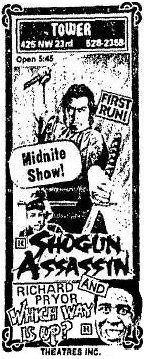 By July 25, 1979, through January 16, 1985, Oklahoman ads appear to show that the Tower was operated by an organization called, "Theatres Inc." I say "appear" since information in the Oklahoman archives is not sufficiently precise to be certain, but, putting together the pieces of available evidence described below, that conclusion appears to be a near certainty.
By July 25, 1979, through January 16, 1985, Oklahoman ads appear to show that the Tower was operated by an organization called, "Theatres Inc." I say "appear" since information in the Oklahoman archives is not sufficiently precise to be certain, but, putting together the pieces of available evidence described below, that conclusion appears to be a near certainty. Part of the available objective evidence is the graphic design for movie ads and remembering that movie "group" ads were collectively shown under a collective banner.
By July 25, 1979, Tower ads began appearing in a picture-frame design standing alone and not as part of a theater group. Initially, no attribution to ownership or management was shown in the ads but that changed when the Winchester Drive-In was added to the "picture frame" group following a December 17 ad. A December 31, 1980, ad which included the Winchester gave the name "Theatres Inc." to the group. The identification and frame design continued until September 7, 1983.
 By September 14, 1983, ad design changed from a picture frame to a box bordered by a column of right-pointed triangles when a new theater, the May Twin, was added to the group. Most often, no management or ownership name was used but on occasion the name "Theatres Inc." continued to appear. From July 29, 1979 through January 16, 1985, ads were generally continuous, with exceptions. No Tower ads appeared after June 14, 1983, until early September 1983, or after August 22, 1984, until December 1984. The January 16, 1985, ad was the last Tower advertisement that I located for regular movie showings at the theater. To see a collage of ads during the 1979-1985 period, click here.
By September 14, 1983, ad design changed from a picture frame to a box bordered by a column of right-pointed triangles when a new theater, the May Twin, was added to the group. Most often, no management or ownership name was used but on occasion the name "Theatres Inc." continued to appear. From July 29, 1979 through January 16, 1985, ads were generally continuous, with exceptions. No Tower ads appeared after June 14, 1983, until early September 1983, or after August 22, 1984, until December 1984. The January 16, 1985, ad was the last Tower advertisement that I located for regular movie showings at the theater. To see a collage of ads during the 1979-1985 period, click here.But, just who or what was "Theatres Inc.?" An article appearing on September 2, 1983, supports the conclusion that "Theaters Inc." was George Shanbour, at least in a representative capacity of the Farris Shanbour family. The September 2, 1983, article described the reopening of the May Theater as the "May Twin." Part of the article reads,
City theater owner George Shanbour has remodeled and reopened the May theater, 1515 N May, under the new name May Twin. The old-style, spacious theater has been halved with two separate screens now available for viewing.If a logical syllogism has application to answering the question, "Who or what was Theatre, Inc.," judging by this article and other indirect evidence the answer was George Shanbour, brother of Farris Shanbour who steered the Tower through its "2nd Golden Period," Farris having died May 31, 1981. I don't know the particulars, but it is clear that after Farris Shanbour's death the Tower Theatre (and other movie venues) remained in family hands.
Shanbour has been in the Oklahoma city theater business for 25 years and also owns Tower Theater, 425 NW 23, and Winchester Drive-in, 6930 S. Western. He also leases Plaza Theater, 1725 NW 16. ¶ Except for the drive-in, all are old style theaters, a species almost as rare as the snail darter.
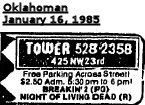 But, the end of the Tower as a theater which showed movies on a regular daily basis was done, just as it had become or was quickly becoming for the other vintage single-screen survivors. A November 9, 1986, Oklahoman article told the sad, nostalgic story. The graphic from that article appears below.
But, the end of the Tower as a theater which showed movies on a regular daily basis was done, just as it had become or was quickly becoming for the other vintage single-screen survivors. A November 9, 1986, Oklahoman article told the sad, nostalgic story. The graphic from that article appears below.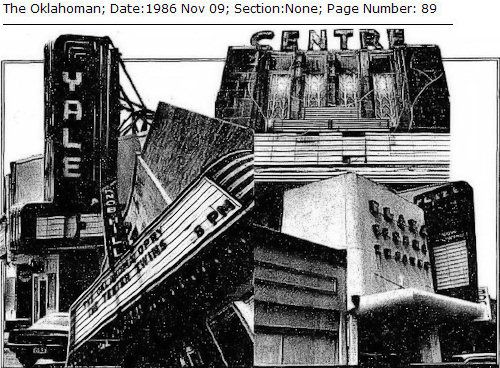
The last regular movie ad that I located for the Tower is the one shown above for January 16, 1985. One of the movies show in the double feature was, appropriately and ironically named, "Night of the Living Dead."
DOWN BUT NOT OUT. Oklahoma County Clerk records reflect that the Tower remained in the hands of members of the Shanbour family until November 3, 2005. During this period, the family made no further attempts to revive the Tower as a regular movie venue. The November 9, 1986, article mentioned above does say that, at the time, the Tower was showing "Spanish-speaking" movies on Wednesdays and Sundays but for how long that happened I don't know.
Otherwise, except for one year — January 1999 through January 2000 — the Oklahoman archives are silent as to the Tower as an entertainment venue. But, that single year reflected a period of vitality even if the vitality was different than the movie heritage upon which the Tower was historically based.
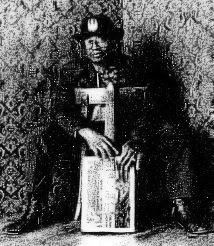 For a twelve-month period of time, it was the Tower's year of music. The not-so-great image at the right is a picture of Bo Diddley (whose proper name was Ellas Otha Bates) in a January 10, 1999, Oklahoman article. During this 12-month period, about 30 items in the Oklahoman reflect the Tower's serving as a venue for a greater-than-30 live performances by musicians performing at the Tower, usually rock but sometimes blues. Granted, none of those performing had the status of Mr. Diddley.
For a twelve-month period of time, it was the Tower's year of music. The not-so-great image at the right is a picture of Bo Diddley (whose proper name was Ellas Otha Bates) in a January 10, 1999, Oklahoman article. During this 12-month period, about 30 items in the Oklahoman reflect the Tower's serving as a venue for a greater-than-30 live performances by musicians performing at the Tower, usually rock but sometimes blues. Granted, none of those performing had the status of Mr. Diddley.I've put together a collage of the Oklahoman's notices of upcoming performances and a thumbnail of the collage appears below. Click here or on the thumbnail for a readable version of what the Oklahoman's archives reflect during this period of time.
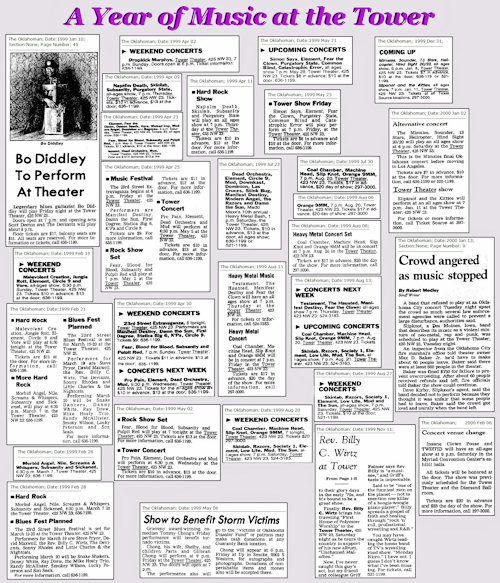
During this time, it looked as though the Tower may well have a re-or-new birth vis a vis some sort of reincarnation approach should the theory be applicable to buildings as well as humans ...
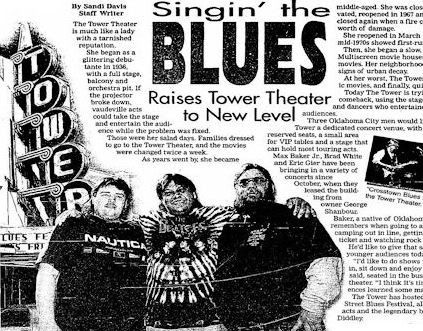
... but it would not last. A Des Moines band named, "Slipknot," was the last band scheduled to play at the Tower that I could locate — but, even though a sellout crowd was present, the performance didn't happen. Theater operator (not owner like the article says) Max Baker had oversold the performance, with at least 880 in attendance. The city fire marshal's office required that about 60 leave and that happened. Slipknot was not impressed, thinking it unfair that some had to leave, and decided not to perform, which made the audience not impressed and unruly. See this January 13, 2000, article for a little more. A concert scheduled for February 12, 2000, was canceled and this version of the Tower's sound of music was done.
After that, I was unable to locate other events held in the Tower though there may be an ad hoc use here and there which was not picked up by the Oklahoman's on-line search engine.
But, other developments affecting the Tower did occur. See this this August 10, 1998, article by Jack Money which discussed public improvements being made along NW 23rd Street between I-235 and Villa Avenue. In the article, the Uptown 23 Association was reported as wanting to preserve the street's unique commercial nature, including art-deco buildings like the Tower and the Gold Dome at NW 23rd & Classen. The group also advocated the establishment of a design-review district along the same portion of NW 23rd. Michael D. Smith, then the organization's vice president, was quoted as saying,
"If that (gold dome) building wasn't there and there was just another brown box at that corner, when you went by you might think you were in Amarillo. There is no reverence or respect for things that are unique — there is a lack of that. That comes with age, education and experience."In that same regard, see this related December 1998 article by Jack Money and Steve Lackmeyer.
Apparently the city adopted no ordinances to implement the design-review aspirations of the group since, according to the Tower's present website, such developments still sound like they are prospective and hoped-for in nature, as late as the date this part of the article you're reading is written. The website says,
Uptown 23 a 501-C3 business and property owners association formed in 1993 to support the revitalization of an important section of the NW 23rd Street Commercial Corridor between I-235 and Villa Avenue.THE TOWER'S REBIRTH — WILL IT EVER HAPPEN? The lingering ownership of the Tower by Shanbour family interests finally came to an end on November 3, 2005, when title was transferred to Uptown Development Group, LLC. Apparently the Journal Record was the first news source to report on what that acquisition might mean. In its June 2, 2006, issue, a major article by Kevan Goff-Parker reported as follows:
Presently, we are working with the Oklahoma City Planning Department to develop new zoning ordinances for the area which will promote the establishment of new neighborhood commercial businesses, restaurants, services and entertainment venues. At the top of our list of priorities is the reopening of the historic Tower Theater. We believe that the events and activities of this important multi-purpose venue and its restored landmark marquee will serve as a beacon to energetic entrepreneurs and real estate investors who will in turn provide the driving force for the ongoing revitalization of Oklahoma City's most important street.
The Tower Theater in uptown OKC - a miracle on 23rd Street?Yes, yes, and more yes's! There's plenty of public interest, but the property was purchased almost 4 years ago and it has been more than 3 years since the above Journal Record article was written.
You'll have to forgive Scott Fife and Marty Dillon if they seem like excited kids in a candy store as they show off the badly dilapidated Tower Theater and adjoining storefronts in uptown Oklahoma City. ¶ Although it looks more like a bedraggled damsel in distress rather than the grand dame that once sparkled when it opened during the late 1930s, the Tower Theater at 425 NW 23rd St. has simply stolen the 40-somethings' hearts.
Fife, Dillon and their partners, Terri Sadler-Goad and Matt Goad, see the theater with rose-colored glasses and envision a day soon when it will be restored and renewed into a thing of true beauty once again.
"I've always liked this place," Dillon recently said as he and Fife used a flashlight to light up the darkened theater. "I played music here in the early 1980s when I was with Wild Youth. I played here at Halloween and they were playing the movie 'Dawn of the Dead.'"
* * *
The Tower Theater has been empty for more than five years. ¶ We want to renovate it, but right now we're getting our funding in order, Fife said. We have been approved for state and national historic preservation tax credits. We want to bring the complex back to its original art-deco look through the guidance of the Oklahoma Historical Society.
Dillon described a wide array of changes Uptown Development Group and a local architect, Brian Fitzsimmons, hope to make to the facility in order to change into a thriving arts and entertainment destination.
* * *
We need a signature concert venue in Oklahoma City, he [Scott Fife] said. ¶ Dillon said the Tower Theater, when restored, will be the right capacity for promoters wanting quality sound because of the great acoustics in the venue.
Plans include transforming some of the space into a two-level Irish pub, installing possible skyboxes in the theater and converting the complex into a mix of retail and entertainment spots. ¶ Fife said the group plans to fix the decaying marquee and believes it will become the calling card for uptown.
But there's plenty to do before leasing offices or installing restaurants and bars. Fife said the group plans to bring the complex up to fire code, work needs to be done on the roof, air conditioning, the plumbing and electrical system.
* * *
We're pretty close on funding, Fife said. We believe it will take eight months to renovate the theater. We're also working in an economic empowerment zone and with the area's community action agency. There's a lot of interest from city leaders in what we're doing.
Is it ever gonna happen?
Photos of the Tower's battered marquee pretty much remained unchanged from the time that Uptown Development acquired the property in 2005 through 2008. Truck drivers got too close to the curb and bashed the sign a time or two and it became downright UGLY. A couple of photos taken after the new owners took over shows what we had become used to seeing -- click the images for larger views:
Courtesy Jason Bondy Photos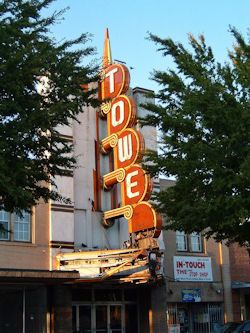 | Credit atilitynut.com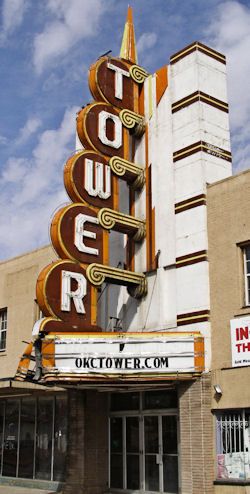 |
Hope remains to resurrect the historic Tower TheaterI ain't tellin' Steve that 'cause I've got eyes (and a camera) of my own! Living about 4-5 blocks from the Tower, I drive through that area frequently. On May 28, 2009, I had my camera in hand and caught what was beginning to happen with the marquee ... the battered part of the signage was being removed ... click images for larger views.
Two years have come and passed since owners of the Tower Theater on NW 23 declared their intentions to bring the iconic property back to life.
To date, the sign that was once a beacon for the Uptown district remains battered and dark. But don’t assume this deal is dead.Driving along the stretch Monday, I encountered owner Marty Dillon and an old familiar face — Greg Banta. Banta, widely credited for bring life back to nearby Midtown and its landmark, the Plaza Court, is now working as a leasing agent for Dillon and advising on how to best market the property.
The pair was doing just that Monday, writing up a list on cleaning up debris and making the storefronts more presentable through the use of multicolored neon lighting. * * *
* * *
Some might think the years of delays at the Tower indicate that the project is without hope — after all, isn’t the economy tanking? Naysayers might argue the Tower’s time has come and gone. But just an hour before visiting with Dillon and Banta, I visited the Sieber Hotel Apartments in MidTown.
The renovation of the dilapidated landmark took a decade to get done. Even after construction was finally under way, the project had naysayers who swore it would never come back to life. ¶ Consider the Sieber’s rebirth, and then tell me again the Tower Theater is hopeless.
 | 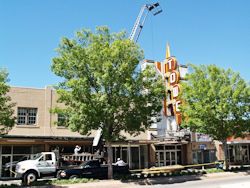 |
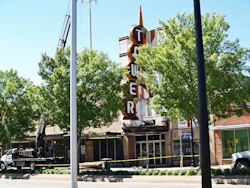 | 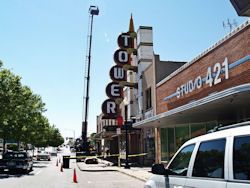 |
Marquee Revamp Conveys Sign of Uptown’s ProgressAccording to the County Assessor's website, here's a general schematic of the Tower Building & Theater properties -- notice that the theater is to the north and the street-front business properties are on the south:
Steve Lackmeyer, Business Writer
The smashed marquee at the Tower Theater is gone and the letters are back in place — a hint that renovations are finally getting under way at the Uptown landmark. ¶ Owner Marty Dillon said months of delays are over and the marquee will soon return, fully restored. His family's company, Party Galaxy, is preparing to move into 3,000 square feet of renovated space on the second floor of the building at 528 NW 23.
"Everybody wants to see progress before they decide anything when it comes to leasing," Dillon said. "I think the sign will be the first step in making that happen." ¶ Dillon said the $2.5 million renovation will include the facade of the theater and adjoining storefronts. Talks, meanwhile, are under way with potential restaurant operators for the first floor. Future use of the former theater space won’t be decided until a restaurant operator is chosen, Dillon said.
"If a restaurant operator wants to take on the whole facility, they can lease that, as well as restaurant space," Dillon said. "Or Uptown Development (Dillon's development company) is willing to manage and run the theater space. It can run either way." ¶ Dillon is continuing to work with former Mid-Town developer Greg Banta, who admits leasing in the current economy isn’t easy. But he's confident that with successful development at NW 23 and Shartel, where Cuppies and Joe is the neighborhood rage, and continued success at NW 23 and Hudson with Cheevers, the Uptown area's resurgence is in full swing. ¶ He notes yet another restaurant, Big Truck Tacos, is scheduled to open this summer in another Dillon property at NW 23 and Dewey, across the street from the Tower Theater.
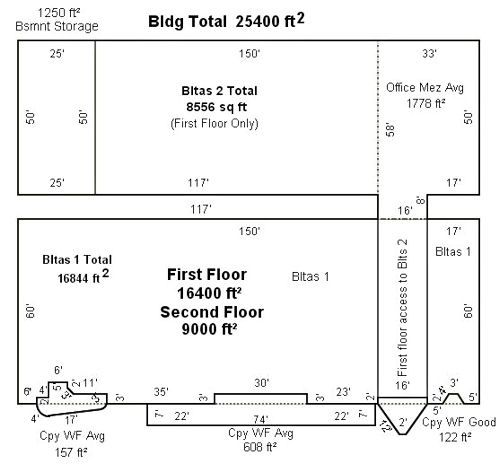
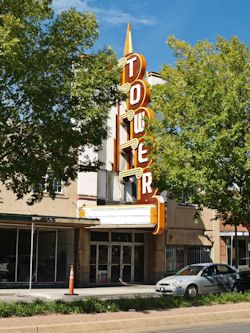 |  |
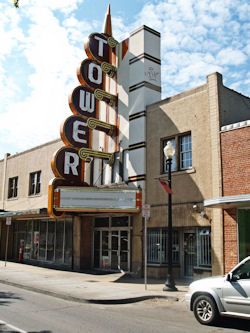 |  |
Looking Into Office Redos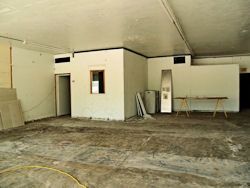 | Looking into Tower Lobby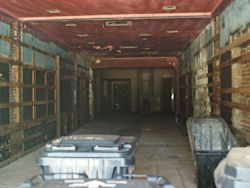 |
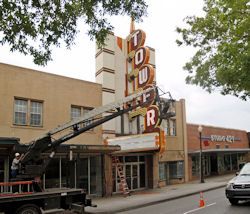 |  |
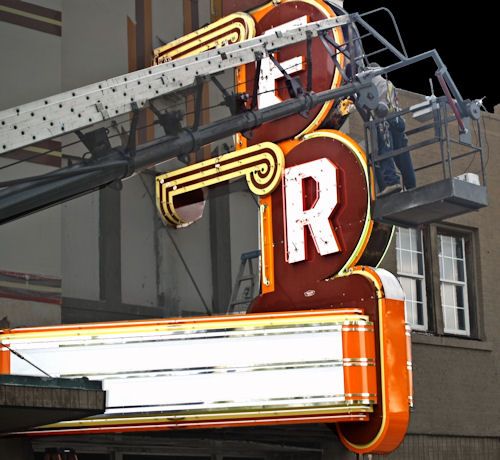
Is the Tower coming back? You betcha!














9 comments:
What is the remnant of the Victoria now? Is that the building kitty-corner from the Safeway/Homeland with all the odd crenelations and spires?
Yep. That's the one. I'll have more on the Tower shortly ... just getting back to finish it.
I have been in the Victoria. The owner has his office on the stage with the stage arch towering over the entrance to his office.
Late to the party...
I remember seeing "Bambi" with my brother at the Tower. Would have been aroune 67 or 68. I remember my mother rear-ended some one out front when she was coming to pick us up. The windshield of the station wagon was cracked where my sister hit her head and bit her tongue. Obviously before seat belts.
Ten-ish years later, there was Tower Records on the corner. My wife met Herby Hancock there for an autographing. Tried to talk the girls into visting them back stage or some such. I was just a pre-20 year old working out at some oil patch at the time. (No, she didn't take him up on the offer).
Funny...memories. The Tower will always have a fond spot with me.
The Victoria is the offices of Charles Shadid. He is the same partner mentioned earlier in the article. George Grube of Heritage Theates was an usher at that theatre.
I was always told that the word théâtre was French for theater. While working on a degree in Film and Video at O.U., we were allowed to use either forms interchangeably.
As for the area, the Big Truck Tacos people have remodeled the building just east of their location and opened it up as a store. Across from them is the motel & restaurant supply which seems to be in a 5-year going out of business sale. I hope they can resurrect The Tower like they did for The Plaza. I realize that's a stretch as Inasmuch poured a huge infusion of cash to fully remodel and equip The Plaza into a top market venue.
Anything new on the Tower?!?
Tower appears to be some what renovated on the outside of the theater but, it continues to be
closed with no sign a change. Most of the other stores on both sides of the theater are also closed and appear to be vacated...too bad!
Is the Tower slated to be opened any time in 2013? If not, someone should try to obtain funding and buy out the owner before it crumbles into a state of non repair.
Post a Comment